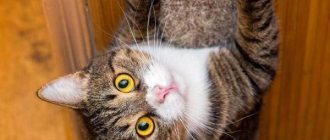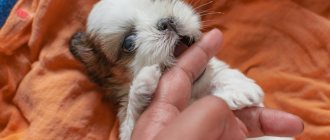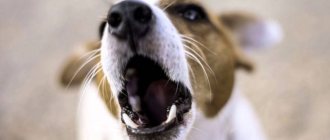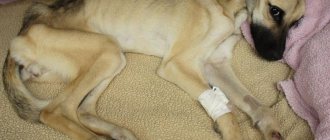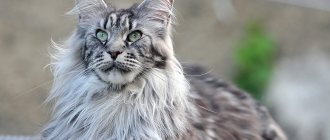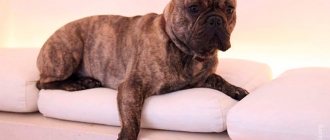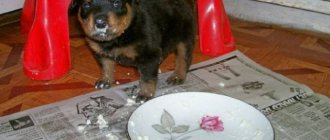Regardless of how thin or obese the cat is, this will in any case negatively affect its health. Regardless of the condition, the animal develops a phalanx of certain pathologies. If you are faced with the fact that your cat has lost a lot of weight, we will tell you what to do in this case.
Normal weight and causes of exhaustion
The average weight of an adult cat varies from 3 to 6 kg. This indicator depends on:
- Way of life.
- Genetic factors.
- Type and quality of food.
- Age and health status.
- Gender and breed.
Healthy pet A veterinarian will help determine the ideal weight for a particular cat. In addition, in order to monitor your pet’s health, it must be shown to a doctor once every six months.
| Breed | Small | Average | Large | ||||||
| normal | full | thick | normal | full | thick | normal | full | thick | |
| Abyssinian | 3.4 | 3.7 | 4.3 | 4.3 | 4.7 | 5.1 | 5.1 | 5.6 | 6.1 |
| British Shorthair | 3.7 | 4.2 | 4.8 | 4.8 | 5.3 | 5.7 | 5.8 | 6.5 | 6.9 |
| Scottish lop-eared | 4.0 | 4.5 | 4.8 | 5.0 | 5.5 | 6.0 | 6.0 | 6.6 | 7.2 |
| Sphinx | 3.4 | 3.7 | 4.1 | 4.3 | 4.7 | 5.1 | 5.1 | 5.6 | 6.1 |
| Persian | 3.8 | 4.2 | 4.6 | 4.8 | 5.2 | 5.7 | 5.7 | 6.3 | 6.8 |
| Maine Coon | 5.8 | 6.4 | 7.0 | 7.3 | 8.0 | 8.8 | 8.8 | 9.6 | 10.5 |
| Munchkin | 3.0 | 3.6 | 4.0 | 4.1 | 4.5 | 4.9 | 5.0 | 5.3 | 5.8 |
If the cat does not reach the lower limit of weight (based on the table above), this indicates exhaustion of the body. The reason may be:
- Forced starvation (if the animal was lost and lived on the street for a long time).
- Stress (for example, a change of place of residence or the arrival of new people in the family).
- Lack of appetite (results from a number of diseases).
- Dysphagia (eating disorders, inability to swallow food, caused by diseases or injuries of the esophagus, foreign objects entering the esophagus).
- Regurgitation or vomiting (results from a number of diseases).
- Metabolic disease.
- Diseases of the urinary system.
- Increased energy consumption due to high activity.
Wasting Wasting can be considered an animal losing more than 10% of its initial body weight. The causes of this condition may be different, in any case, the cat needs care and treatment prescribed by a veterinarian. In such situations, it is better not to self-medicate.
Nutritional considerations for overweight cats
When fighting obesity in a pet, you need to follow the same rule as in humans: calorie expenditure should exceed their intake. This is the only way to get your cat in shape and avoid the development of complications due to excess weight. Pet owners can consider two options: special medicinal food or natural food (natural food), each of which has advantages and disadvantages.
Table: pros and cons of different forms of nutrition
| Straight | Cat food | ||
| Advantages | Flaws | Advantages | Flaws |
| Low cost | The need to calculate the amount of calories, proteins, fats and carbohydrates | Veterinarian-proven effectiveness in treating obesity or dystrophy in cats | High cost (especially premium food) |
| Possibility of cooking at home (confidence in the composition) | Cooking time costs | Possibility to choose various flavorings and additives | Inability to check the composition yourself |
| Food can be of any consistency | Limited food options (not always suitable for cats with allergies) | Many brands of manufacturers (you can choose food for each pet based on individual characteristics) | Only solid or jelly-like consistency |
Which food to choose
If cats are obese, it is better to use expensive food with the most natural composition. They should contain the amount of proteins, fats, carbohydrates, vitamins and minerals that the cat needs, as well as plant fibers. This will help avoid forced starvation and nutritional deficiencies.
It is better to use dry food for feeding obese cats: the animal chews hard pieces more slowly, which contributes to satiety. And also after such a snack, your pet will definitely drink water, which also reduces space in the stomach.
How to properly transfer an animal to diet food
A sudden change in the usual diet can cause serious stress in your pet, which will also negatively affect its health. That is why it is necessary to switch to dietary nutrition gradually: over 7–9 days in young animals and about 10–12 days in older ones. Basic principles of cat adaptation:
- Every day, add 1 teaspoon of new food, proportionally reducing the amount of old. At the same time, there is no need to force the cat to finish eating if it does not like the new food. If you are switching from natural to food or vice versa, adhere to the same principle: introduce new products gradually.
- When changing wet food to dry food, you can soak it a little (especially for old cats or very young kittens). To do this, use water or low-fat broths.
- In the first few days, the animal may experience a change in stool consistency. If this symptom lasts for a week, you should contact your veterinarian and change the diet.
The transition from one food to another is carried out gradually
A feeder with a timer will be a useful purchase for owners of cats suffering from obesity. One of my friends worked all day and was unable to feed his pet regularly. Previously, he poured him a large bowl of food, which the cat ate within several hours, and in the evening he received another huge portion, which contributed to the appearance of excess weight. The solution to this problem was a feeder with a timer: at a certain time it poured out the required amount of food. This helped the cat not only lose weight, but also normalize his food intake by the hour.
What to do if your pet constantly asks for food
When organizing meals for obese cats, it is important to consider that their stomach is slightly larger than normal. This means that if they reduce their usual serving size, they may experience significant discomfort. In this case, it is recommended to increase the number of feedings, but reduce the amount of food the cat consumes. Veterinarians advise strictly adhering to nutritional standards and not following your pet’s lead, since even a slight excess of calories can reduce all the results of the diet to zero.
The animal should always have drinking water freely available. Many cats confuse hunger with thirst, resulting in them eating extra food in an attempt to compensate for the fluid deficiency.
Do not forget about rewards: even if you are overweight, you should not deprive your pet of his favorite treat. One of my colleagues had a Scottish Fold cat who suffered from obesity and was put on a strict diet. But every day the owner gave him 3-5 catnip pads, which helped suppress his appetite and hold on until the next meal. In this way, two goals were achieved at once: the cat did not ask for food and experienced pleasure from the treat.
Organization of natural nutrition for an obese cat
When feeding natural products, it is worth considering that your pet is primarily a carnivore, and the basis of its diet should be animal proteins. You should not sharply limit the amount of fat or switch your cat only to plant-based foods: this can lead to the development of serious liver and stomach diseases.
Veterinarians also do not advise mixing natural food and food: the animal must be accustomed to one type of food. You should also not add salt, other seasonings or flavor enhancers to animal dishes.
Nutrition for obese cats:
- The source of proteins and fats and the main food product is meat (beef, chicken, turkey) and offal (liver, hearts). It is better to avoid pork and lamb - they are too fatty for the cat’s gastrointestinal tract and are difficult to digest. The meat can be given raw in the form of cubes or boiled.
- Fish for cat food is used no more than 1-2 times a week, only sea fish, with a small amount of fat (pink salmon, salmon, trout). It needs to be boiled, scales and bones removed so that the animal does not choke or get injured while eating.
- Dairy products are a source of calcium, so they should also be included in the diet. To feed overweight cats, it is better to choose low-fat yogurt, kefir or cottage cheese.
- Cereals are used as a source of slow carbohydrates. For pets, you can cook oatmeal, buckwheat, rice, barley in water or lean broth.
- Vegetables are also good for the cat's body, as they contain many carbohydrates, vitamins and minerals, and they are also rich in fiber, which improves digestion. Your pet's diet should include carrots, green beans, zucchini, pumpkin, broccoli, asparagus and any greens (lettuce, celery, parsley, dill, green onions). It is better to boil vegetables or serve them raw, cut into small pieces.
Photo gallery: healthy foods when feeding natural food
Vegetables are rich in vitamins and minerals
Cottage cheese is the best source of calcium
Meat is rich in animal protein
General tips for shaping your diet
To properly organize feeding your pet, you must adhere to the following rules:
- The weight of food consumed daily should be calculated by a veterinarian based on information about the cat’s breed, age and degree of obesity. On average, this amount does not exceed 3–5% of the animal’s body weight (in sphinxes this value may be increased due to excess heat production in the body).
- Food should be given in small portions at strictly defined times (it is better if at this moment you yourself eat or have a snack). It is recommended to feed your cat every 3 hours (for example, at 8, 11, 14, 17, 21, 24 hours), you can use a feeder with a timer for this.
- Do not give your pet pieces from the table and stop begging from guests. This could cause your fur baby to beg for his favorite treat and ruin his diet.
How long should you stick to this diet?
Your cat's weight loss should occur gradually. With strict adherence to the diet and dosed physical activity, your pet can lose excess weight within 5-9 months. If you have been adhering to the restrictions for more than a year, and the animal’s weight remains the same, you need to reconsider the diet and choose different food or other products for natural nutrition.
Anorexia
The disease can be called an extreme degree of exhaustion only conditionally.
Anorexia is characterized by severe thinness due to a dulled feeling of hunger. And if in humans the reasons are obvious, then in cats everything is not so simple. Let's list some of them:
- Chemotherapy course. Treatment of malignant tumors is often accompanied by a host of side effects. One of them is a radical refusal to eat. The cat loses interest in food, refuses to play, prefers to hide in secluded places and sleeps a lot.
- Consequences of a major operation . Medicines, including anesthesia, greatly affect the pet’s mood and its orientation in space. They can have a detrimental effect not only on taste preferences, but also completely deprive them of interest in food. Even months later, your cat may still feel the effects of a major surgery.
- Failure of the senses. Usually associated with traumatic brain injuries. This leads to disturbances in neural communication, loss of taste or smell. The cat simply does not understand what is edible and what is not. She can experiment, but in most cases she will get a negative experience. All this leads to the described illness.
Anorexia is very different from simple weight loss. In this case, simple fattening is not enough. In any case, you should contact a veterinarian, get tested and undergo a course of treatment.
What to feed to gain weight?
There are feeds for increasing the weight of animals, called medicinal, but they are more expensive than usual. However, if the pet is in critical condition and does not digest natural food well, this is the only feeding option.
If the weight loss is insignificant, you can fatten your pet with natural products. Weight gain is achieved by intelligently replacing proteins with carbohydrates. It is better to avoid fatty foods (or reduce them to a minimum); strive to gain muscle mass, not fat.
From hand
What can you feed your cat to make him fat?
- Meat : rabbit, chicken should be in the diet daily (60-75% of the total diet). To eliminate the risk of infection with worms, the meat must be deep frozen (sometimes it can be boiled) before consumption.
- Fish : ocean only. Make sure that there are no bones in the fish, as they contribute to the development of diseases of the urinary organs.
- Eggs (white and yolk): boiled and raw. Use no more than 2 times a week, 1 pc.
- Dairy products : cottage cheese, sour cream, unsweetened yogurt. It can be introduced into the diet gradually; it is better not to use store-bought products.
- Milk should be completely excluded from the diet of a domestic cat, as it puts a lot of stress on the liver and is poorly digested.
- Hard cheese . Useful in small doses; if overused, it can overload the liver.
- Cereals : rice, buckwheat, millet, etc. 1 teaspoon for each meal.
- Fruits . If the cat doesn’t mind, then you can, but you shouldn’t force feed it.
- Greens : parsley, dill, lettuce. Greens help improve digestion, so it is useful to add them to every meal.
- Oils : sunflower, flaxseed, olive. Only as a supplement.
Your task is to formulate your cat’s daily routine so that the body has to spend as little energy as possible. Reaching the golden mean is difficult, especially if the pet is overly active and picky about food.
Attention! Avoid sausages, canned meat and fish; such products contain a lot of salt and spices. They can harm the cat's digestive system.
Nutrition needs to be reviewed
To speed up the weight gain process, use vitamin supplements. They activate metabolism, which will force the body to digest and absorb food faster. It is important to consult your veterinarian before using vitamins.
How to fatten a thin kitten (cat) that was starving?
The main principle of fattening is that the calorie content of food should exceed energy expenditure. Meat should be its main source. Thin animals are fed little by little 5-6 times a day. A large amount of food eaten at once creates excess stress on the digestive organs. You can't suddenly change your diet.
Food should be warm (30–40°C) - in this form it is better absorbed and also smells stronger, which increases appetite. Pre-chopping foods makes digestion easier. The animal must have 24/7 access to clean water. A cat that has been starving is not getting the nutrients it needs, so it should be given vitamin and mineral supplements. First of all, a depleted coma needs vitamins A, C, D, E, and group B.
How to identify excessive thinness in a pet
Due to the large number of breeds, many cats have significant differences in appearance. This is why some people may mistake a slender and lean animal for an emaciated one. You need to know the difference between physiological and pathological thinness.
Signs of a healthy cat with a slender physique:
- the proportions between the sizes of the head, torso and limbs are observed;
- ribs and vertebrae are not visible through the layer of wool, but are easily found when palpated;
- the waist is pronounced;
- there is a thin layer of fat in the chest and abdomen area;
- the animal is active, plays a lot and eats with appetite;
- The coat is smooth, shiny, easy to comb and does not fall out.
Oriental breed cats have well-developed muscle mass and a small layer of fat
With pathological thinness, the following signs are observed:
- protruding shoulder blades, ribs, hip bones are visible to the naked eye;
- the head and ears are sharply enlarged compared to the body, the limbs are thin;
- the muscles are poorly developed, fatty tissue on the abdomen and back cannot be felt;
- the fur falls out in uneven tufts, there may be tangles;
- the animal spends a lot of time sleeping, moves little, and changes in appetite are observed (ravenous hunger or complete lack of desire to eat).
When a cat is emaciated, bones can be seen through the skin.
Is fattening required?
How can you tell if a cat is thin, has a normal weight, or is “fat”? First of all, there are a number of important points to note:
- The owner should not compare it with the pets of friends, neighbors, or close relatives. After all, in this matter there is individuality. Even 2 kittens from the same litter can have different constitutions: 1 is excessively thin, and the second is well-fed.
- If we are talking about purebred pets, then there are certain standards. Typically, the table indicates both minimum and maximum data - height and body weight.
- If the cat is of “noble” origin, then you will have to navigate “by eye,” or rather, by touch. The animal should be placed in a standing position - the front legs are straight, the hind legs are slightly pulled back, in the direction of the tail. You need to feel his spine, it should be smooth. While stroking your pet, the outer ribs should not be felt, and this is considered normal. Then the pelvic part is palpated - a moderately well-fed animal has a smooth croup, with slightly protruding knuckles. The abdomen may be taut or slightly saggy. When moving, a fold forms in the peritoneum area - this is also normal. There is a thin layer of fat on the sternum and abdomen that can be felt.
As a rule, even skinny representatives of the species develop a small layer of fat in the cold season.
External signs of thinness. A pet can be called thin if it has:
- the spinal column and ribs are visible upon visual inspection;
- the hip joints clearly protrude into tubercles;
- a depression is noticeable in the area of the peritoneum;
- the muscles of the forearms, hind limbs, and sternum “fall off.”
The constitution and muscle tone of the animal are always taken into account. Many of the cats appear thin in appearance, but at the same time they have developed muscles.
We make a calculation.
It is impossible to calculate the “ideal” weight of a pet using mathematical calculations of coefficients or a formula.
For example, the standard weight of “British women” varies from 4.2 to 6.8 kg. However, there is a recorded case where a male of this breed reached a weight of just under 14 kg. At the same time, he was physically healthy, although the giant was still excluded from breeding (read in the article how much a cat should weigh depending on breed and age).
Recipe No. 2
Fresh meat for lunch:
- Chicken breast - 100 g.
- Lean pork meat (can be replaced) - 30 g.
- Rice - 1 tbsp. spoon.
- Chopped parsley - a handful.
- Vegetable oil - 1 teaspoon.
Chop the meat with a knife and mix with the rest of the ingredients. Store for no more than 2 days.
Fresh meat for lunch
Why does my cat need to lose weight?
A single kilogram of excess weight already increases the risk of your pet developing serious diseases. Unfortunately, if your cat is overweight or obese, it is no longer a question of whether she will develop complications and illnesses associated with it, but when exactly they will appear and how serious they will be. Most often, excess weight is accompanied by:
- Type II diabetes – it is three times more common in obese cats than in animals of normal weight;
- Heart diseases;
- Increased risk of joint injuries;
- Osteoarthrosis (arthritis);
- High pressure;
- Some forms of cancer, especially tumors in the abdominal cavity.
Overweight and obese animals tend to live shorter lives than their slender counterparts. If a cat is overweight, it moves less and becomes less energetic and playful. The purr prefers to just lie down, and because of this it is easy to miss the first signs of illness, mistaking lethargy for “normal laziness.”
Now we are just beginning to understand the danger that extra pounds can pose to both humans and their four-legged friends.
Choosing a kitten in 10 steps. Blog of user Mira88 on 7ya.ru
So, you have decided to get serious about buying a purebred kitten and want to know how this should happen.
Below I will give a few key points that must be taken into account so that the purchase does not cause disappointment. Choose and buy a kitten personally. The kitten should be chosen by the future owner himself, or by the owners if the family consists of several people. Remember that you choose not only a kitten, but also a breeder with whom you will have to communicate after the purchase for advice. Before... Discussion
Today there is still a lot of pain that animals endure, so to speak, and you know in such a situation it is still quite important to choose the same kitten with a full package of documents. Yes, I agree with you that this way you will have to spend more money than even buying a kitten from the market, but at the same time you will be sure that the cat is healthy
In addition, when I adopted the kitten three months ago, even though I had documents, I took the kitten for examination to a doctor.
Recipe No. 5
Milk breakfast:
- Powdered milk - 1 tbsp. spoon.
- Chicken eggs - 2 pcs.
- Cottage cheese - 3 tbsp. spoons.
- Chopped vegetables - 2 tbsp. spoons.
Add a few tablespoons of cold water to the milk powder, then beat in the eggs and bring the mixture until smooth. Gradually stir in cottage cheese and vegetables. Pour the mixture into the pan and cook for 2 minutes on each side. Cool, cut and serve to your pet.
Milk breakfast
Attention! Remember, no salt or spices should be used in any recipe. They will irritate the animal’s receptors, which will negatively affect its sense of smell and perception of taste.
Sources of fats
This element must be included in a cat’s natural diet, since it is not only, along with carbohydrates, a source of energy, but also supplies the body with many vitamins:
- A - improves vision, is responsible for the condition of the skin and coat;
- D - is of great importance for the formation of the skeleton;
- E - strengthens muscles, regulates the normal functioning of the genitourinary system;
- K - is an important element for strengthening joints and bones, and the functioning of the cardiovascular system.
In addition, fats give food an attractive taste and smell, promote intensive growth and harmonious development of the animal. Their share in the pet’s diet with natural nutrition should be at least 20%.
If it is not possible to provide the animal with food with a sufficient amount of these components, then fish oil can be added to it.
Mistakes and dangers
A common belief is that cats will not eat anything that can harm them. In fact, this is not so; pets often eat food that is not healthy and even harmful to them. Most often this happens because their owners make the following mistakes:
- They feed from the table. Pets often ask to share human food, and not all owners can resist. Remember, your food contains a large amount of salt and spices, which are harmful to the digestion of animals.
- Mix types of food. Decide on your pet’s type of food: natural or industrial food. Both methods have their advantages and disadvantages, but combining them leads to indigestion.
- They ignore daily norms. It is easy to feed a cat to be fat, since this simply requires giving him an unlimited amount of food every day. If you do not pursue such a goal, it is better to stick to the daily intake (discuss with your veterinarian).
- They switch abruptly from one type of food to another (from natural to dry food). The change in feeding method must be smooth, otherwise the pet will develop vomiting or diarrhea.
Recommendations from experts
When fattening an animal, it is especially important not to harm it. Therefore, you should listen to the recommendations of experts:
- Do not mix different brands of food. This leads to an imbalance of elements, which will have a negative impact on the pet’s health.
- It is better to avoid food that can be easily purchased in any supermarket (for example, Whiskas, Kitiket). Such economy-class feeds lead to diseases of the genitourinary system, the formation of kidney stones, pancreatitis and other pathologies.
- Cats are clean and groom themselves constantly. Accordingly, wool enters the digestive system. This can cause problems in weakened animals. To help pets, they need to be given Maltpaste. It helps naturally remove hairballs from the digestive tract.
Maltpaste is designed to remove hairballs from the digestive tract of cats.
What feed is best to use?
If the cat is very thin and emaciated, then a veterinarian will help you choose the right diet. Most often, experts recommend using ready-made dietary products that are sold in pet pharmacies.
The most popular brands are:
- Hill's a/d;
- Royal Canin Recovery;
Royal Canin Recovery food is well suited for cats that are weak or sick, it is easily digestible and gives the animal a lot of energy.
- ProPlan Convalescence.
All these diet foods are produced in the form of soft food - pates. This form was not chosen by chance. Soft food is easier to digest, and this is what a depleted body needs. The gastrointestinal tract will not be overloaded and the cat will not spend extra energy on digestion. If the cat is exhausted to such an extent that she can no longer eat on her own, then this kind of nutrition can be easily administered through a tube.
The food is distinguished by a high content of elements such as fat and proteins, vitamins and minerals. Thanks to this composition, the body recovers faster.
Wet food is also used for emaciated kittens. This diet is high in calories and also contains more vitamins necessary not only for recovery, but also for growth.
It is better not to use dry food during this period. They belong to tough and solid foods. Depending on the reasons for weight loss, not every cat will be able to easily digest such food.
Table: Comparison of cat foods that promote weight gain
| Name of food | Class | View | Features of the composition | Effect | Price |
| Royal Canin Recovery | Premium | Wet | Poultry liver, corn starch, taurine, vitamins | Improved absorption of nutrients | 1200 RUR (195 g). |
| ProPlan Convalescence Support Cat | Premium | Wet | Pork or poultry, dried egg white, minerals | Proteins, fats and carbohydrates are better absorbed | 60 r (100 g). |
| Hill's a/d | Superpremium | Wet | Turkey liver, chicken, pork, fish oil | Stimulation of metabolic processes, weight gain | 120 RUR (156 g). |
| Applaws Chicken & Duck | Superpremium | Wet | Chicken meat, chicken broth, duck fillet | Restoring body weight, preventing excess weight loss |
|
Photo gallery: foods that promote weight gain
Applaws Chicken & Duck promotes weight gain
Hill's a/d improves the recovery of an exhausted cat
Royal Canin Recovery helps you maintain your desired weight
How long does it take to train a cat to go on a diet?
Give your cat a week or two to get used to the new diet. First, mix ¼ of the new food with ¾ of the usual food for 2 to 4 days. Then increase the amount of new food to half, and in the last 3 to 5 days before the final transition to the new diet - to ¾.
To improve palatability, you can heat the food and add flavoring additives, for example, based on fish oil containing Omega-3 fatty acids.
If your cat refuses a new diet, or if you have any questions while introducing her to a new food, do not hesitate to contact your veterinarian for advice.
Is it necessary to add additional vitamins, microelements and minerals to the diet?
If a cat is fattened with commercially prepared food, then, as a rule, it does not need any additional vitamin complexes. There are some cases where the exhaustion of an animal has affected its health, and one or another vitamin may be required to correct it. Then the doctor will prescribe such a supplement in a certain proportion and for a certain period.
When a cat eats only natural food, vitamin-mineral complexes should always be present as a supplement. Veterinary pharmacies today have a fairly large selection of such drugs. But it is worth distinguishing between vitamin and mineral complexes for kittens and adult animals.
The drugs in greatest demand are:
- for kittens: GIMPET Baby-tabs;
- Beaphar Kittys junior;
- 8 in 1 Excel Brewers;
8 in 1 Excel Brewers are considered a universal complex; regular use prevents the development of vitamin deficiency and improves metabolism.
- Canina cat mineral with calcium;
- Hartz Everyday Chewable Vitamins with Taurine;
- Pharmax;
ANIVITAL products are developed based on natural ingredients and help to effectively solve many current health problems in dogs and cats.

